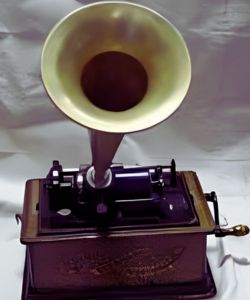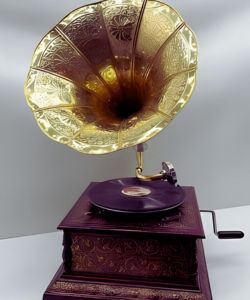The story goes back to the day when I came across a YouTube video where the host was narrating the history of record players and turntables. The video was informative until he referred to the phonograph and the gramophone as the same thing. I won’t mention the video here because humans can also make mistakes, and it’s okay.
Right after the video, a quick thought came to my mind: There may be other people unaware of the difference between these two devices and I could help them with the right information.
If you are someone who thought both devices were the same, stay tuned. Today, we will discuss the main differences between these two devices in detail.
Just in case you are in a hurry, here is a quick difference between the two for you!
| Phonograph | Gramophone | |
| Definition | It was the first audio recording device that used tin foil and wax cylinder to record and playback sound. | It was an upgraded version of a phonograph that used shellac discs as a medium to record and playback sound using mechanical energy. |
| Invented by | Thomas Edison | Emile Berline |
| Year | 1877 | 1887 |
| Recording and playback Medium | Tin foil cylinder, wax coated cardboard cylinder and all wax cylinders | Shellac records (Flat discs) |
| Stylus | Cutting stylus was used to record the sound and playback stylus to create sound from grooves. | Single stylus that was made of metal, fiber or thorn. |
| Variant | 2 minute and 4 minute phonograph | Wind-up, horned, hornless, tabletop, picnic and cabinet gramophone |
| Speed (RPM) | 120 RPM | Early discs were played at 60-130 RPM, which was later fixed to 78 RPM |
| Reusability of medium | Yes | No |
| Sound recording by end user | Possible | Not possible |
| Playback time | 4 minutes | Initially it was 3-4 minutes that was later increased to 4-5 minutes. |
| Operates on | Mechanical energy | Mechanical energy |
| Sound quality | Being the first device, sound quality was poor | Sound quality was much better |
| Availability | Rare | Easy to find |
| Cost | Rare to find hence expensive | Less expensive |
| Impact | Laid the foundation for audio technology. | Used a flat disc, which ultimately became the dominant medium for years to come. |
What is a phonograph?

The phonograph was invented by Thomas Edison in 1877 at the Menlo Park lab. It used a cylinder wrapped in tin foil and a needle to record sound.
It functioned in such a way that whenever a sound was produced, vibrations were transferred through the horn to the diaphragm and from there to the cutting stylus that engraved grooves on the tin foil cylinder, thus recording the sound. To play back the sound, a playback stylus followed the grooves and reproduced the recorded sound.
Later, the model was modified by Alexander Graham Bell, who used a wax cylinder instead of tin foil to record the sound.
Read more about the history of record players here.
What is a gramophone?

The gramophone was invented in 1887 by Emile Berliner, a German-American inventor. It was an upgraded version of the phonograph that used flat discs (shellac) to record and playback sound instead of wax cylinders.
The device had a diaphragm attached to the needle that etched spiral grooves on the disc, which later produced sound. The horizontal spiral grooves made it easier for the stylus to track the grooves, thus improving the overall sound quality.
Difference between a phonograph and a gramophone
Let us now discuss in detail the difference between these two devices.
Recording and playback medium
In phonographs, cylinders made of tin foil and wax were used to record and playback the audio.
In gramophones, flat discs (also known as records today) made of shellac were used for sound recordings and playbacks.
Recording mechanism
Both devices had similar mechanisms for recording sound, but the mediums differed. The phonograph had a horn attached to a diaphragm, connected to a cutting needle that recorded vibrations by engraving vertical grooves on a tin foil or wax cylinder.
The gramophone also had a diaphragm connected to a needle, but it etched spiral grooves on a flat disc.
Playback mechanism
In a phonograph, playback involved rotating the cylinder, which caused the playback stylus or needle to track the grooves on the cylinder, producing vibrations that generated sound.
In a gramophone, playback required rotating the shellac disc with a hand crank, allowing the needle to track the spiral grooves, causing vibrations that produced the sound.
Sound quality
Both devices had different ways to track the grooves. While the phonograph tracked the etched grooves vertically on the tin foil or wax cylinder, the gramophone, on the other hand, tracked the spiral grooves horizontally. The horizontal groove tracking technique proved to be better as it helped the stylus to track the grooves more effectively and thus improved sound.
Furthermore, the gramophone provided high fidelity with a broader frequency range because of the superior recording medium (shellac), which improved the overall sound experience.
Playback time
The playback time on a phonograph was initially only a few seconds when using tin-foil cylinders, but this was later increased to 2 and 4 minutes using wax cylinders.
On the other hand, the shellac records used in gramophones had a playback time of 3-4 minutes on each side that was later increased to 4-5 minutes.
Reusability of the recording medium
The phonograph allowed users to reuse the wax cylinder by removing the old grooves and re-recording the new sound. This allowed users to record sound themselves.
The gramophone used a flat disc that could not be reused and did not allow the end-user to record sound.
Durability
Both devices were durable when well taken care of. In fact, some old phonographs and gramophones are still operational to this day.
When comparing the durability of the recording mediums they used, flat discs were less prone to damage compared to the tin foil and wax cylinders used in phonographs.
Impact
Edison’s phonograph laid the foundation for audio technology that revolutionized the entertainment industry by providing a medium to record and playback sound.
On the other hand, Berliner’s gramophone was an improved version of the phonograph that used a flat disc, which ultimately became the dominant medium for recording and playing back music for years to come.
Cost
A fully functional phonograph is hard to find these days, and even if you can find one, it won’t come at a cheap price.
On the other hand, you can still buy a working gramophone online that can play shellac records for you.
Final beat
Both of these devices brought an audio revolution and shaped the music industry. The turntables and record players we see today originated from their innovation. Although they differed in the recording mediums and how they recorded and played back sound, both played a pivotal role in advancing the music industry.
I hope you now understand the significant differences between the two devices. If you have any further questions, feel free to ask in the comments below!


